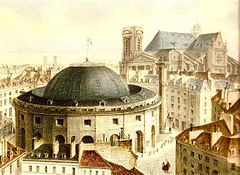Halle au blé (Paris)
| Halle aux blés | |
|---|---|

Hall in 1838, Medici column to its right
|
|
| General information | |
| Type | Corn exchange |
| Address | 2, rue de Viarmes |
| Town or city | Paris (1st arrondissement) |
| Country | France |
| Coordinates | 48°51′46″N 2°20′34″E / 48.862731°N 2.342780°ECoordinates: 48°51′46″N 2°20′34″E / 48.862731°N 2.342780°E |
| Construction started | 1763 |
| Opened | 1767 |
| Closed | 1873 |
| Demolished | 1887 |
The Halle aux blés (Corn Exchange) was a circular building in central Paris used by grain traders built in 1763–67, with an open-air interior court that was capped by a wooden dome in 1783, then by an iron dome in 1811. In a major reconstruction in 1888–89 much of the structure was replaced and the building became the Bourse de commerce. The structure influenced the design of public buildings in Britain and the United States.
The city of Paris purchased the site of the former Hôtel de Soissons in 1755. The hôtel had been demolished and its materials sold, but the Medici column was left standing. On 23 November 1762 King Louis XV of France (1710–74) declared that a hall of grain and flour (halle aux blés et farines) would be built on the site. Construction of the hall began in 1763 following a design by Nicolas Le Camus de Mézières (1721–89), who supervised the work. The circular hall surrounding a circular courtyard was completed in 1767. Six roads radiated from the Rue Viarmes, which ran around the hall.
Work on a wooden dome to cover the courtyard began on 10 September 1782 and was completed on 31 January 1783. The wooden dome was destroyed by fire in 1802. An imperial decree of 4 September 1807 stated that the hall was to be covered by a dome with cast-iron vertical arches covered in tinned copper. The replacement was complete in 1811. The building, now made entirely of stone, brick, iron and copper, was considered fireproof. In 1854 there was another fire in the building.
By the start of the Second French Empire (1852–70) the hall was no longer used to store flour. It was too small to serve the needs of the two million inhabitants of Paris and had become a sort of bourse, or exchange for titles to grain from Beauce, Brie and Picardy, and flour from the mills of Seine-et-Marne and Seine-et-Oise. The grain and flour was then delivered via rail direct from the provinces to the bakers and merchants. Fortunes were made and lost through speculation, not always honestly. The corn exchange was closed in 1873. In 1885 the building was assigned to the Commodities Exchange.
...
Wikipedia

